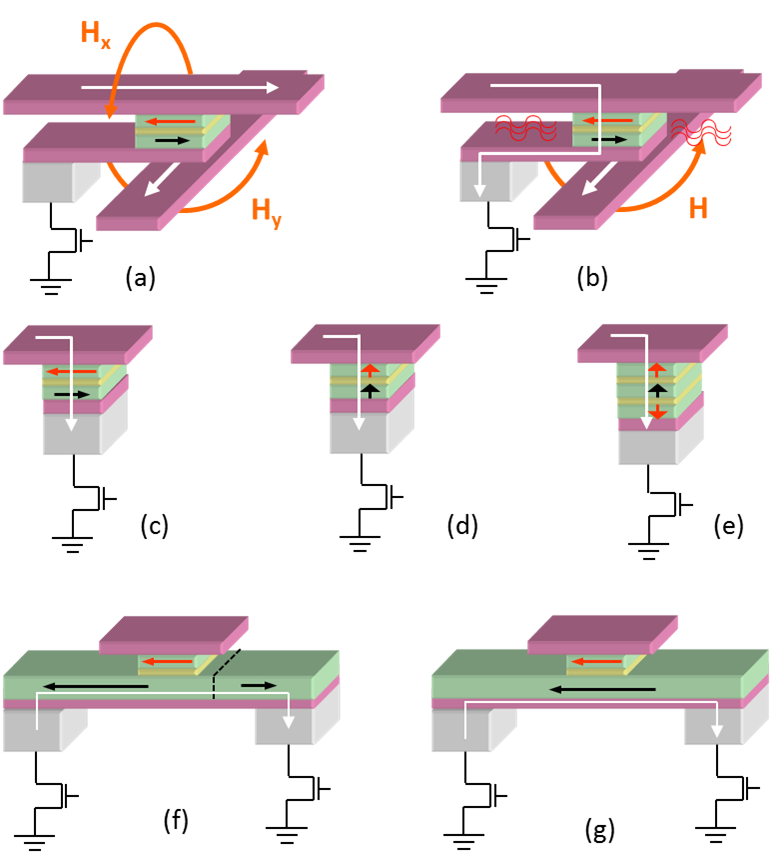Thematic overview
Magnetic Random Access Memories (MRAM) is a non-volatile memory technology, where information is stored by the magnetization direction of magnetic electrodes, very similar to computer hard-disk drives. The goal for MRAM memory is to simultaneously achieve high-speed read/write times, high density and unlimited cycling compared to other existing and emerging technologies.
Our group is developing advanced MRAM cell concepts patented at Spintec. The concepts are based on the use of temperature to reduce power consumption and increase the stability of the stored information. These ideas go beyond the conventional MRAM approach. The naturally occurring temperature increase during the write step is not lost, but is instead used to achieve the seemingly opposing goal of lowering the power consumption and increasing the thermal stability in the operating temperature range. Our group fosters young and experienced researchers developing/applying their expertise in the field of MRAM.

Questions to be addressed
Our main research axis is to use the naturally occurring temperature increase during the write step, when a current flows through the magnetic tunnel junction. The heating is used to go above a temperature threshold, making it possible to write the storage layer magnetization. This principle has been applied to in-plane magnetization cells using a storage layer pinned by an anti-ferromagnet and recently to perpendicular anisotropy cells. Our group’s goal is to demonstrate the proof-of-concept and then improve MRAM cell properties.
Our work involves the development of magnetic material systems, nano-fabrication (20-200nm cells), characterization of devices (magnetic & electrical) and simulation of the device behavior. Our activity in these vast fields is as follows;: On materials research, we are developing magnetic tunnel junctions with in-plane and perpendicular magnetic anisotropy. New electrode stacks having the material properties required by each specific concept need to be integrated in magnetic tunnel junctions, while achieving high levels of TMR signal. For the characterization of each concept we determine the write window parameters in terms of magnetic field, power consumption and magnetization reversal dynamics. Macrospin and micromagnetic simulation provide a better physical understanding of the system properties and the possibilities for optimization.
Projects
ANR EXCALYB – Perpendicular Anisotropy Materials for High-Density Non-volatile Magnetic Memory Cells
Crocus R&D – Thermally assisted MRAM
Samsung SGMI
Partners
Crocus Technology
Institut Néel
SP2M/NM
SAMSUNG
Applied Materials
SINGULUS
Recent news
- PhD Defense – All-optical switching of spintronic devices [January 12th, 2024]
On Wednesday January 31th, at 10:00, David Salomoni (SPINTEC) will defend (in english) his PhD thesis entitled : All-optical switching of spintronic devices Place : IRIG/SPINTEC, CEA Building 10.05, auditorium 445 (access needs authorization request it before ... - PhD Defense – Magnetic Memories Optimized for Cryoelectronic Operation [November 16th, 2023]
On Monday December 04th, at 14:00, Pedro Brandao Veiga (SPINTEC) will defend his PhD thesis entitled : Magnetic Memories Optimized for Cryoelectronic Operation Place : IRIG/SPINTEC, Amphithéâtre Daniel Dautreppe, Bâtiment B, CEA – 17 rue des Martyrs ... - In plane reorientation induced single laser pulse magnetization reversal [October 27th, 2023]
We demonstrate that single pulse all optical helicity independent switching can be generalized for a large range of rare earth–transition metal multilayers. The threshold fluence for switching is observed to be independent of the pulse ... - Spiking neuron based on magnetic tunnel junction with dual free layer [October 27th, 2023]
We demonstrate that a perpendicular magnetic tunnel junction (MTJ) is capable of emulating an artificial spiked neuron. The magnetic stack has been designed so that the MTJ has two free layers, whose magnetization can be ... - Three years engineer researcher position [October 27th, 2023]
Spintec laboratory is opening a up-to three years engineer researcher position in the framework of the PEPR electronics (part of France 2030 strategy) – project EMCOM (emerging memories for computing). Context: The cost of transferring information ...
SOUSA Ricardo
ricardo.sousa@cea.fr
BALTZ Vincent
vincent.baltz@cea.fr
PREJBEANU Lucian
lucian.prejbeanu@cea.fr
DIENY Bernard
bernard.dieny@cea.fr
